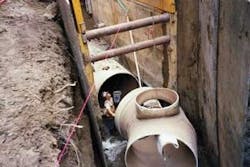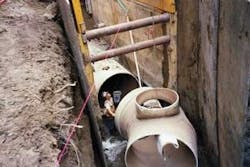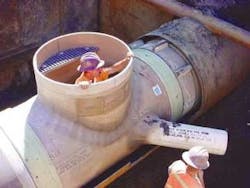Pipe Project Saves Park During Sewer Upgrade
Situated in the heart of the Tualatin Valley, midway between majestic Mount Hood and the spectacular Oregon coast, Beaverton, OR, is a city that devotes 1,000 acres to 100 parks so one is within a half mile of every home. With this emphasis on green space, Clean Water Services, the regional wastewater and stormwater utility, set the highest priority on reliability in planning a sewer upgrade through Tualatin Hills Park and Recreation District's 219-acre Nature Park.
Following the Beaverton Creek stream corridor, the new sewer line would replace the old one that was too deteriorated to repair. According to Steve Lampert, one of Clean Water Services' project managers, "The main consideration was we didn't want to have to go back out to the wetlands to make repairs."
Project specifications included 8,000 feet of pipe – 2,100 feet of 48 inch, 3,700 feet of 60 inch and 2,200 feet of 66 inch. The alternatives were profile wall polyethylene and centrifugally cast, fiberglass-reinforced, polymer mortar (Hobas CCFRPM) pipe. Neither of these is affected by hydrogen sulfide.
High Stiffness Design
The contractor, John L. Jersey & Son, Inc. of Portland, OR, bid the job with Hobas CCFRPM pipes. John F. Kalkhoven, P.E., Jersey project manager, said that strength and durability were two of the important reasons his firm chose the pipe. He explained that the profile wall polyethylene was not as stiff as the Hobas product and it would require additional care to insure a quality installation.
"The polyethylene pipe would have required a filter cloth liner for the excavation and complete coverage with bedding rock," he said.
The CCFRPM pipe's trench did not require filter fabric and needed bedding only up to the springline.
"Jersey & Son told Clean Water Services' staff during an interview that Hobas pipe would cost less than the profile wall option to install and would make installation easier," Lampert said.
Fiberglass System
In order to accommodate the many changes on the sewer line as it followed the meandering creek, Jersey installed manholes. It wasn't uncommon to have a series of manhole runs of only 100 feet, 70 feet, 130 feet then 500 feet.
"The custom-made manholes simplified this task," Kalkhoven said.
Hobas manufactured each manhole with the correct miter and FWC couplings so that they were easily joined.
"For the first 2,000 feet of pipe, we were limited to an easement 30 feet wide," Kalkhoven said. "Since the excavation for the 66 inch pipe was eight feet wide, we had an 11 foot path to bring everything in. All the pipe and bedding had to come from behind but this was no problem. We'd lay the pipe, then install the tee-base manhole and proceed to the next joint. After the manhole bases were installed, we put the risers in place and added the cover. The risers were delivered complete including fiberglass ladders."
The 48-inch-diameter manhole risers were reduced to a standard 24 inch top. Hobas also made the manhole covers, which were attached with a gasket and bolts ensuring they would be watertight as the summer water levels rise.
The company supplied a complete package that included the pipe, manhole tee bases, risers and lids, Lampert said.
While the actual cost of Hobas pipe was higher, it was the less expensive option on a total installed cost basis, Lambert said.
According to Jersey & Son, the cost of the cloth liner, extra bedding and additional labor for a more difficult installation clinched the decision.
"The numbers stood on their own based on my view," said Lampert. "Also, it would provide an end product that Clean Water Services could be comfortable with."
Hobas pipe is manufactured in sizes from 18 inches to 110 inches in pressure and non-pressure classes. For more information, visit the company's website at www.hobaspipe.com.


